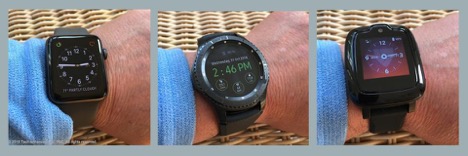Emergency alert devices go modern, but old TV ad catchphrase won’t fade away
SENIOR TECH – Almost everyone remembers the 1980s commercial in which an elderly woman lies on the floor next to her toppled walker crying “Help! I’ve fallen and I can’t get up.” Sitcoms from the Golden Girls to Fresh Prince of Belair used it as a reliable laugh line into the ‘90s. It was also fodder for plenty of memes. In 2007, the ad was trademarked by the Life Alert mobile emergency response system.
So you know you’ve reached a certain age when younger relatives tell you to get one. To that original simple pendant connected to a base has now been added cell phone apps and smartwatches with an alert system. The old device might still suffice for people who spend most of their time at home
However, the unanimous response to my question, ‘‘Which type of emergency alert system would you prefer?” was: “It’s a great idea, but I don’t need one yet.”

How many people have you seen wearing a pendant? Possibly none, because most people wear them under their clothes. You must be wearing the pendant for it to work. Disadvantages? It needs to be connected to a base, and both base and pendant need charging. They’re not particularly attractive. And it’s a symbol of frailty.
It only works if you wear it
I heard many horror stories of people who had fallen in the bath or garden and weren’t wearing the pendant. Did I mention it is unattractive? By luck they were discovered and received help. Dr. Richard Caro, who organizes circles of “Longevity Explorers” to research and test apps and devices that are useful to seniors, admits that the group most satisfied with the pendant were those in the 90-and-above age range, and lived in a residential facility.
Many more people plan to use their cell phones in an emergency. But one problem with the cell phone—if you even have it with you—is that you have to unlock it, click open the app, then push the alert button. This is fine, unless you’re incapacitated or unconscious from a fall or stroke. What if you can’t unscramble “911” in your head or tell responders where you are?
But who you gonna call? Say you unlock the phone, open the app and push the emergency button. You can dial 911 directly, or you can alert a family member, or reach a monitoring service which talks to you and assesses the situation before making the next call to 911. You don’t need connection to a base, but you do need cell service and a reliable monitoring system. And cell service can be notoriously spotty.
So, now that you’ve called, where are you? Again, if you’re compos mentis and alert, you can give your address or location. If you’ve had a stroke, you won’t be able to say anything. In this case a GPS feature in the app will save the day. Unless the GPS doesn’t locate you or is off by a couple of blocks! One app includes a loud siren to help locate your prone self, if the GPS is wonky.
Smartwatches to the rescue
If stroke is your biggest fear, peace of mind might come easier with a Fall Detector app, which does what it sounds like. The problem here is that you can’t take the cell phone into the shower, where many falls take place.

Mobile alert systems are currently designing devices that look like, and in some cases function as, smartwatches. Some have the added advantage of being water-resistant for up to 1 meter for 30 minutes. Different brands have varying degrees of smartwatch capabilities—some tell time and the weather and that’s it. Others include amenities like step-counting, heart rate, pulse rate and similar fitness trackers. Then there’s the Apple smartwatch that includes an alert feature and has an add-on fall detector app.
For an in-depth look at mobile alert systems and an extensive review of various options, see Tech-enhanced Life. The website identifies types of alert systems, describes research and testing methods, provides selection tools and recommends systems tailored to different needs. Co-founded by Caro, Tech-enhanced Life explores the intersection of aging and technology, to improve the quality of life of older adults and their families.
Apple watch Mobile HelpSmart Freedom Guardian





